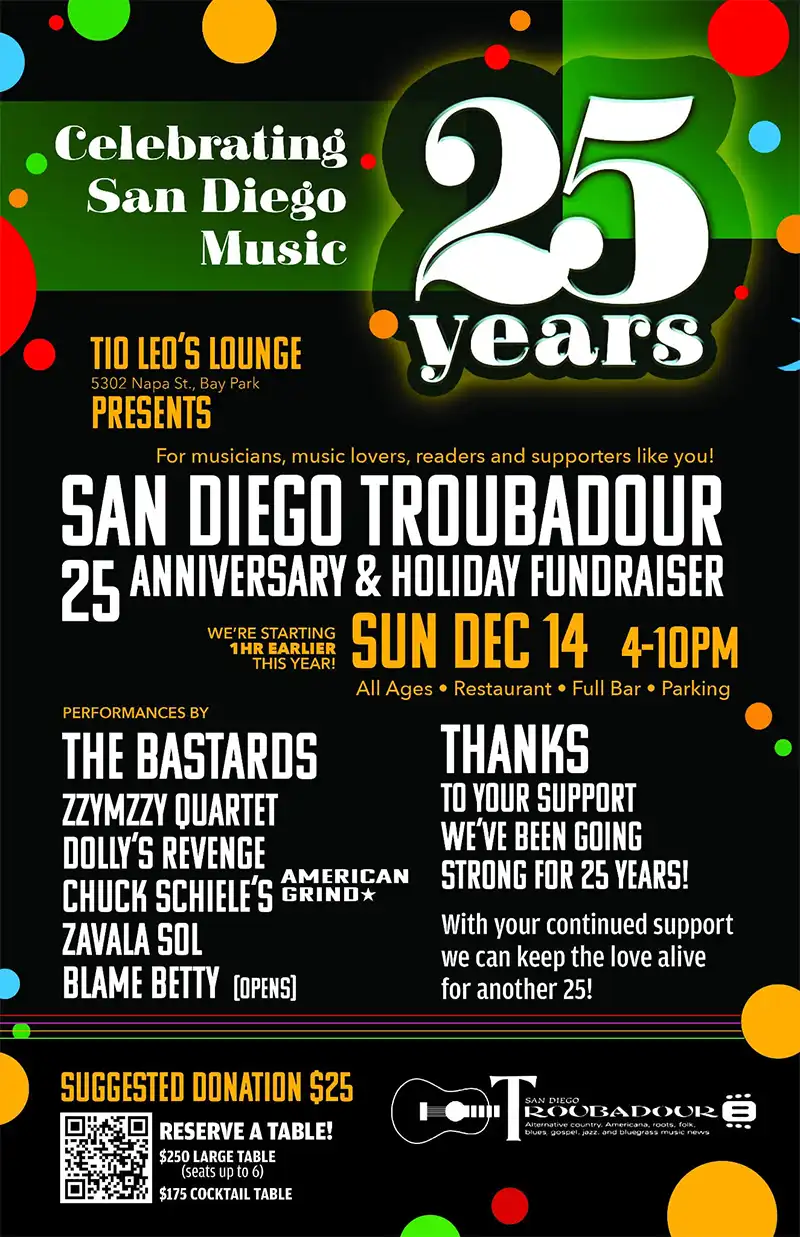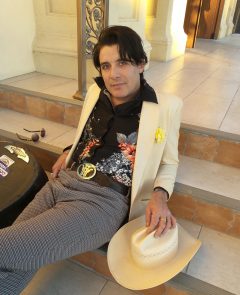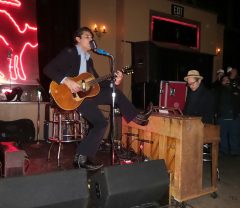Featured Stories
Stephen El Rey: The King of Americana
I first saw Stephen Rey, or “Stephen El Rey” as he’s known on stage, perform sometime around 2012 at the Black Cat Bar, the wonderfully dim-lit, chandeliered bar that feels like a New Orleans funeral parlour. When he walked in the door I thought I was looking at someone who stepped out of a David Lynch movie. A tall, thin, suave vampire dressed in black, with jet black hair greased back: classic Americana from another time. On stage, his songs certainly could have served as the soundtrack to a Lynchian film. His songwriting draws on the sounds of the ’50s, a time when rock ‘n’ roll was a new idea that still lived in the same house as country and blues. From one breath to the next, Rey’s voice channeled the vulnerability of Roy Orbison, the sex of Elvis Presley, the raw power of Howlin’ Wolf, or the insanity of Jerry Lee Lewis. Like Lynch’s movies, Rey’s music can feel familiar, but always carries with it a more complex undertow waiting to pull you in.
Songwriters like Rey feed off of the past and stylize their life in pursuit of inspiration. I once visited his shotgun home in South Park and found inside a glorious curio of Americana artifacts–a blend of rockabilly memorabilia, desert mementos, and genuine antiquities from both sides of the border. Everything had some texture or wear that held a story, and stories are the lifeblood of any songwriter. But, like the best Americana songwriters, Rey doesn’t stop with merely collecting the past: he makes it feel new and present again. In some way or another, this kind of story has played over and over, guiding his creative life. When I asked Rey about his earliest musical influences, the first memory that came to his mind was being at home and cleaning his mother’s rhythm and blues 45s. It was a telling story that distilled his creative life to its essence: making something old sound new again.
Rey’s family’s roots are in the inland, rural communities of the Imperial Valley. His grandfather immigrated to California from Mexico to escape the violence of the Mexican Revolution. His grandfather’s work ethic took him from working in fields to build a trucking business that was the stuff of legends amongst drivers. As a kid, Rey would visit his grandfather’s ranch, where that work ethic was passed on. Everyone in the Rey family was expected to help on the ranch, and most were comfortable repairing and handling a big rig long before receiving a driver’s license.
Rey himself grew up mostly in Lakeside, which sits in something like a transitional zone between San Diego’s coastal and inland communities. Though his family roots connected him to inland, rural traditions, his teenage years were defined by an urban lifestyle that most native San Diegans can relate to: skateboarding, surfing, and punk rock shows. These influences are not as easy to spot in his recordings, but the influence shows on stage, where he is often truly a man possessed by the power of live music. At age 14 he started playing in his first bands, trading mixtapes of Mississippi bluesmen with classmates and letting those sounds of faraway places and mysterious figures take hold in his imagination.
After school ended, Rey lived the classic musician’s life for a brief period: a warehouse for a home, no car, and no money. But, the early lessons of self-sufficiency and hard work learned on his grandfather’s ranch sustained him and brought him to the cusp of something big. His original material attracted the attention of numerous major labels that funded demo recordings. Eventually Rey landed a publishing deal with Warner Chappell records, a welcome break to support the arrival of Rey’s new family. However, it quickly became clear that the life of travel required by the mainstream music industry would take too great a toll on his home life, and he abandoned that path. Instead, he shifted his energies from songwriting to performance as a sideman in beloved local groups like Lady Dottie and the Diamonds, Bartender’s Bible, the Schizophonic Soul Review, and the Little Richards.
Now, years later, with his family fully raised, Rey is picking up where he left off. A stint playing bass in the Johnny Cash tribute band Cash’d Out brought him back onto a national touring circuit and allowed him to share his original material as an opener. Any off-days back at home in San Diego have found Rey in the studio, where he’s constantly bringing together different ensembles whose chemistry lends each session a distinct and spontaneous quality.
In the last year he’s released two EPs with starkly different sounds. His self-titled release on Pig Baby Records as Stephen El Rey is abrasive and raw, the product of a no-frills recording session with a reel-to-reel in Rey’s garage. The recording engineer definitely pushed the needle into the red on this one. The sound hits so hard, you wonder if the garage is still standing. On a cover of Dead Moon’s “Poor Born,” Anders Larsson’s powerfully focused drumming grounds Rey’s crazed howl and, on top of it all, Gabe Sundy’s baritone sax pours a welcome helping of grease. The original “Buried Under the Future,” is a standout: an instrumental piece featuring warped and distorted guitars that sound like Link Wray trying to invent shoegazer.
By comparison, Rey’s self-released EP Sextet is spacious, moody, complex, even dreamy at times. The tunes were cut live in one room at San Diego’s Rarefied Recording, but the lush palette of sounds from an expanded band seems to echo from landscapes across the continent and through time: the reverb-soaked guitars of a Pacific shoreline, the bluesy piano of a gulf swamp barrel house, the soulful horns of Detroit’s Motown, all traveling in some caravan down the lost highways of the Mojave.
When you consider that he has already completed additional sessions at studios based in New Mexico and Memphis, it’s clear that Rey has a lot to say and is not wasting any time. Just like before, Rey’s work is quickly grabbing the attention of the music industry. In August, Rey was selected to perform for the Gondola Sessions, a popular video series that has featured roots luminaries like Bluegrass mandolin legend Sam Bush, as well as newer celebrated roots voices like Aofie O’Donovan, Shakey Graves, and the Carolina Chocolate Drops. In February 2018, he will travel to Memphis, Tennessee where he’s been nominated for an Ameripolitan Award. Like the Gondola Sessions, this nomination places him in good company as previous winners, which include Hank Williams III, Pokey LaFarge, and Junior Brown. The self-described mission of the awards are to revitalize American roots music traditions that have been tarnished or obscured by the ascent of a corporatized “country” music industry. It seems only befitting to nominate someone like Rey who cherishes those childhood memories of restoring an old record collection to it’s original, pristine glory.
Rey will be performing at the Lafayette Hotel on New Year’s Eve, and hopes to release material from his Memphis sessions at the same time. You can find more information about his work and performances at http://stephenelreymusic.com
Clinton Davis is a freelance musician and educator born and raised in Kentucky. Currently based in San Diego, he performs traditional American music as a soloist and with the G Burns Jug Band. For more information, visit http://clintonrossdavis.com








